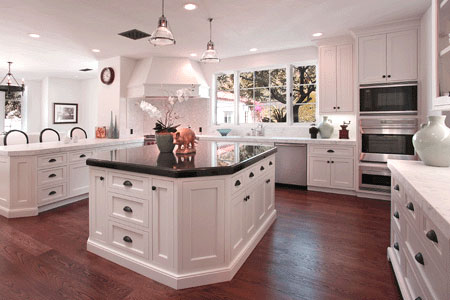
Kitchen staging is one of the main priorities in any house, since the kitchen is considered both the “heart of the home”, as well as one of the main buyer criteria for judging the value of a property. There is no doubt that a shabby kitchen will prevent even the most interested parties from making an offer on your home, while a spotless, organized and updated kitchen will have offers rolling in from multiple prospective buyers.
While a complete kitchen makeover and remodel can be prohibitively expensive for many sellers, some simple and effective kitchen home staging strategies can have the room looking newer, nicer and more modern, for a fraction of the cost.
This resource section provides an easy-to-follow guide for beautifully staging any kitchen space.
Typical Problems with Kitchen Staging
The kitchen is one of the rooms in the house which is difficult to keep constantly clean and organized. Meals are prepared, food is consumed and groceries and utensils have a tendency of accumulating rather quickly to fill every cabinet and drawer.
The kitchen is every professional home stager’s worst nightmare, since they know they can work all day to get a design just right and within a week, the appeal might be completely lost, unless the seller makes a concerted effort to keep the room looking museum-quality.
Likewise, there is a large and sometimes inordinate amount of stress placed on the homeowner to maintain the kitchen beautifully at all times, so that it will shine when a prospective buyer stops by on short notice. This stress is compounded when the rest of the family does not pitch-in to help keep the kitchen clean and neat, placing all the maintenance responsibility on just mom or dad.
Badly-dated countertops, cabinets and appliances can really sidetrack excellent kitchen staging and may require replacement or re-facing. This can increase the staging budget considerably, but luckily, kitchen upgrades almost always come back 100% or more when the home is sold.
Staging a pantry is a great way to enhance the desirability of a dedicated kitchen storage space.
Staging eat-In kitchens combines aspects of dining room staging into the kitchen design plan. Regardless of whether the dining room is separate or attached, be sure to beautify this crucial space, as well.
Breakfast nook staging will improve the functionality and beauty of a charming breakfast area within any kitchen.
Outdoor kitchen staging is a necessary component of properly preparing a back or side yard to wow prospective buyers.
Kitchen Improvements
Kitchen home staging can be professionally done or can be a rather simple DIY project. Let’s discuss the main considerations to keep in mind in the kitchen:
First off, tackle any of the major problematic issues, like appliances which need repairing or replacing.
Next, work on the cabinets and countertops. While replacing or re-facing is great, these can be pricey propositions. If you want more bang for your buck, try painting old cabinets and replacing the hardware for a simple contemporary look.
Countertops can also be painted, using a special primer and acrylic paints. Make sure to top them off with several coats of glossy finish, using a product which is safe for food preparation areas.
If the floor is old, worn or just ugly, consider covering it with a laminate floor or for an even less expensive fix, get some self-stick tiles which mimic a natural stone finish. Both of these types of flooring can be put down in a few hours time, even by a novice.
Replace dated florescent fixtures with efficient and bright fixtures and consider installing simple under cabinet lighting.
Make sure the room is painted in a bright neutral color, which contrasts or coordinates with the rest of the décor.
A quick faucet change out is a cheap fix that can make a big difference, as well.
Easy Kitchen Staging Techniques
Ok, now that the hard work is done, let’s get to the easy stuff.
Make sure to keep window treatments light and airy to maximize natural light.
Clean off the countertops and store away small appliances or other items which usually sit out. You can choose one item to leave exposed, such as a coffee maker.
Organize your cabinets and drawers and do not load them up with stuff.
Leave lots of open space to make the area seem larger. To accomplish this, consider going food shopping for fewer items, more often, if necessary.
Touch up scratches in any of your appliances with enamel paint and be sure to clean everything twice.
Do not keep magnets or notes on your refrigerator.
Avoid cooking or storing food with unpleasant odors and always keep the kitchen smelling good with fresh-baked goods or scented candles.
To create a nice touch, put 2 or 3 stacked cookbooks next to the range and a small vase of fresh flowers nearby.
Your Kitchen Can Sell Your Home!
Paint and your own labor will create a real difference in the kitchen and will cost you next to nothing. I have staged many kitchens with fantastic results by simply painting everything, adding a few inexpensive accessories, eliminating 80% of the clutter and giving the place a terrific cleaning. The total cost can be less than $100. For three times that amount, you can make upgrades in fixtures, flooring and minor repairs, while larger projects may require a bigger budget.
Kitchen staging maintenance may require a few minutes of extra care, twice a day, to make sure that the room always looks nice and is ready to be shown by your real estate sales agent.
Remember to appeal to all 5 senses when staging a kitchen. When you expect buyers, setting out a small arrangement of snacks is one way to welcome them to what may become their new residence.
I dedicate an entire section of my book Learn Home Staging to kitchen staging design tips. If you want your kitchen to be perfect, this is the book you must read.





